
Lucius Tarquinius Superbus was the legendary seventh and final king of Rome, reigning 25 years until the popular uprising that led to the establishment of the Roman Republic. He is commonly known as Tarquin the Proud, from his cognomen Superbus.

According to Roman tradition, Lucretia, anglicized as Lucrece, was a noblewoman in ancient Rome, whose rape by Sextus Tarquinius (Tarquin) and subsequent suicide precipitated a rebellion that overthrew the Roman monarchy and led to the transition of Roman government from a kingdom to a republic. The incident kindled the flames of dissatisfaction over the tyrannical methods of Tarquin's father, Lucius Tarquinius Superbus, the last king of Rome. As a result, the prominent families instituted a republic, drove the extensive royal family of Tarquin from Rome, and successfully defended the republic against attempted Etruscan and Latin intervention.

Tiziano Vecelli or Vecellio, known in English as Titian, was an Italian (Venetian) painter of the Renaissance, considered the most important member of the 16th-century Venetian school. He was born in Pieve di Cadore, near Belluno. During his lifetime he was often called da Cadore, 'from Cadore', taken from his native region.

Lucius Junius Brutus was the semi-legendary founder of the Roman Republic, and traditionally one of its first consuls in 509 BC. He was reputedly responsible for the expulsion of his uncle the Roman king Tarquinius Superbus after the suicide of Lucretia, which led to the overthrow of the Roman monarchy. He was involved in the abdication of fellow consul Tarquinius Collatinus, and executed two of his sons for plotting the restoration of the Tarquins.

The Rape of Lucrece (1594) is a narrative poem by William Shakespeare about the legendary Roman noblewoman Lucretia. In his previous narrative poem, Venus and Adonis (1593), Shakespeare had included a dedicatory letter to his patron, the Earl of Southampton, in which he promised to compose a "graver labour". Accordingly, The Rape of Lucrece has a serious tone throughout.
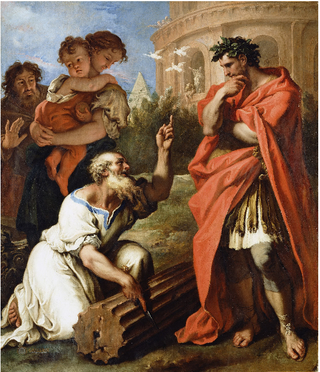
The gens Tarquinia was a plebeian family at ancient Rome, usually associated with Lucius Tarquinius Priscus and Lucius Tarquinius Superbus, the fifth and seventh Kings of Rome. Most of the Tarquinii who appear in history are connected in some way with this dynasty, but a few appear during the later Republic, and others from inscriptions, some dating as late as the fourth century AD.
Demaratus, frequently called Demaratus of Corinth, was the father of Lucius Tarquinius Priscus, the fifth King of Rome, and the grandfather or great-grandfather of Lucius Tarquinius Superbus, the seventh and last Roman king.

Sextus Tarquinius was one of the sons of the last king of Rome, Lucius Tarquinius Superbus. In the original account of the Tarquin dynasty presented by Fabius Pictor, he is the second son, between Titus and Arruns. However, according to Livy and Dionysius of Halicarnassus, he was either the third or first son, respectively. According to Roman tradition, his rape of Lucretia was the precipitating event in the overthrow of the monarchy and the establishment of the Roman Republic.

Lucius Tarquinius Ar. f. Ar. n. Collatinus was one of the first two consuls of the Roman Republic in 509 BC, together with Lucius Junius Brutus. The two men had led the revolution which overthrew the Roman monarchy. He was forced to resign his office and go into exile as a result of the hatred he had helped engender in the people against the former ruling house.

Arruns Tarquinius, commonly called Egerius, was a member of the royal family of early Rome.

The Death of Actaeon is a late work by the Italian Renaissance painter Titian, painted in oil on canvas from about 1559 to his death in 1576 and now in the National Gallery in London. It is very probably one of the two paintings the artist stated he had started and hopes to finish in a letter to their commissioner Philip II of Spain during June 1559. However, most of Titian's work on this painting possibly dates to the late 1560s, but with touches from the 1570s. Titian seems never to have resolved it to his satisfaction, and the painting apparently remained in his studio until his death in 1576. There has been considerable debate as to whether it is finished or not, as with other very late Titians, such as the Flaying of Marsyas, which unlike this has a signature, perhaps an indication of completion.

Tarquin and Lucretia is an oil painting by Titian completed in 1571, when the artist was in his eighties, for Philip II of Spain. It is signed, and considered to have been finished entirely by Titian himself. It is one of a series of great works from Titian's last years, but unlike some of these, is fully finished. It is now in the Fitzwilliam Museum in Cambridge, England.

Salome, or possibly Judith with the Head of Holofernes, is an oil painting which is an early work by the Venetian painter of the late Renaissance, Titian. It is usually thought to represent Salome with the head of John the Baptist. It is usually dated to around 1515 and is now in the Doria Pamphilj Gallery in Rome. Like other paintings of this subject, it has sometimes been considered to represent Judith with the head of Holofernes, the other biblical incident found in art showing a female and a severed male head. Historically, the main figure has also been called Herodias, the mother of Salome.
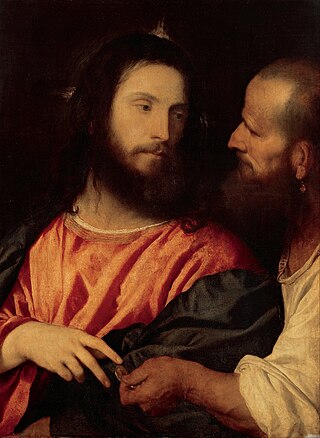
The Tribute Money is a panel painting in oils of 1516 by the Italian late Renaissance artist Titian, now in the Gemäldegalerie Alte Meister in Dresden, Germany. It depicts Christ and a Pharisee at the moment in the Gospels when Christ is shown a coin and says "Render unto Caesar the things that are Caesar's, and unto God the things that are God's". It is signed "Ticianus F.[ecit]", painted on the trim of the left side of the Pharisee's collar.
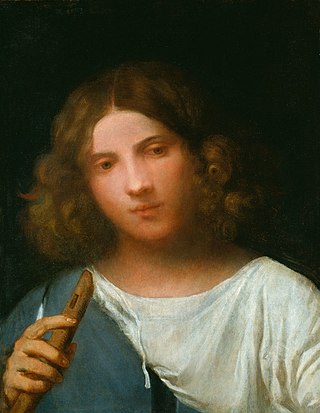
Shepherd with a flute, or Boy with a Pipe, is a painting in oil on canvas of perhaps 1510–1515, in recent decades usually attributed to Titian, though in the past often to Giorgione. It is now in the Royal Collection, and in 2018 was in the King's Closet at Windsor Castle. Since at least 1983 it has been called Boy with a Pipe by the Royal Collection; previous titles the collection recognise include Shepherd with a pipe, and The Shepherd.

The overthrow of the Roman monarchy was an event in ancient Rome that took place between the 6th and 5th centuries BC where a political revolution replaced the then-existing Roman monarchy under Lucius Tarquinius Superbus with a republic. The details of the event were largely forgotten by the Romans a few centuries later; later Roman historians invented a narrative of the events, traditionally dated to c. 509 BC, but this narrative is largely believed to be fictitious by modern scholars.
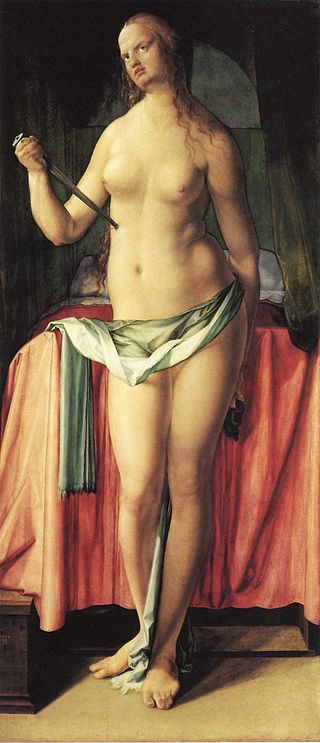
The Suicide of Lucretia is an oil on lime panel painting by Albrecht Dürer, signed and dated 1518, in the collection of the Alte Pinakothek, Munich. It shows the Ancient Romean heroine Lucretia, wife of Lucius Tarquinius Collatinus, in a tall and narrow framing, in the act of killing herself rather than face the shame of being raped by her cousin Sextus Tarquinius. Lucretia stands in front of a cramped and harshly lit room containing the bridal bed on which she was raped. She looks to the sky, as if asking the gods to witness her suicide. Her face betraying feelings of disgrace, as she stabs herself with a sword to the belly. The panel is Dürer's second treatment of Lucretia, following a very similar 1508 drawing. The earlier composition, drawn in ink with wash on paper, is in the Albertina museum, Vienna.
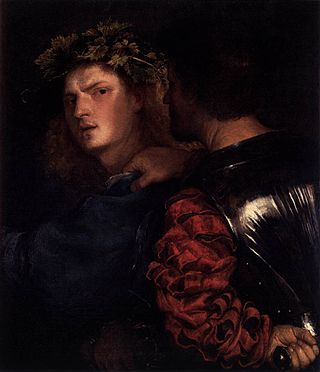
The Bravo is an oil painting usually attributed to Titian, dated to around 1516-17 and now in the Kunsthistorisches Museum in Vienna. The painting can be seen as one of a number of Venetian paintings of the 1510s showing two or three half-length figures with heads close together, often with their expressions and interactions enigmatic. Most of these are "Giorgionesque" genre or tronie subjects where the subjects are anonymous, though the group includes Titian's The Tribute Money, with Christ as the main figure, which in terms of style is similar to this painting, and his Lucretia and her Husband, also in Vienna, where at least the woman's identity is clear, if not that of the man.

The Ca' Dolfin Tiepolos are a series of ten oil paintings made c.1726–1729 by Giovanni Battista Tiepolo for the main reception room or salone of the Palazzo Ca' Dolfin, the palazzo of the patrician Dolfin family in Venice. The paintings are theatrical depictions of events from the history of Ancient Rome, with a typically Venetian emphasis on drama and impact rather than historical accuracy. They were painted on shaped canvases and set into the architecture with frescoed surrounds.

Tarquin and Lucretia is a 1620–1650 oil on canvas painting by Artemisia Gentileschi. It hangs in the Great Hall of the Neues Palais in Potsdam. It is one of three paintings that Gentileschi painted of Lucretia, the wife of Roman consul and general Tarquinus, at the moment of her suicide. The other two versions are in a private collection in Milan and The Getty Museum in Los Angeles.
















